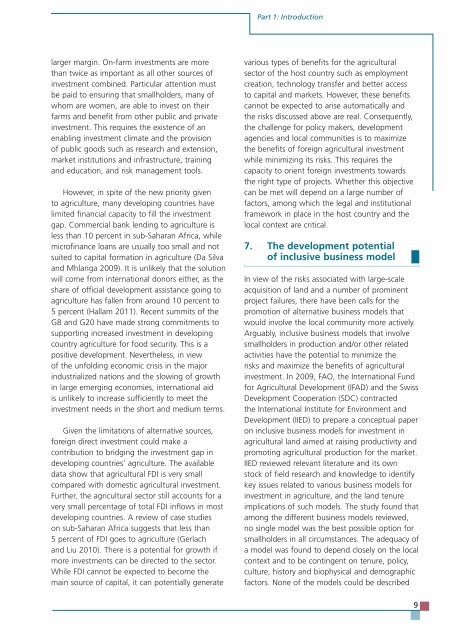TRENDS AND IMPACTS OF FOREIGN INVESTMENT IN DEVELOPING COUNTRY AGRICULTURE
TRENDS AND IMPACTS OF FOREIGN INVESTMENT IN DEVELOPING COUNTRY AGRICULTURE
TRENDS AND IMPACTS OF FOREIGN INVESTMENT IN DEVELOPING COUNTRY AGRICULTURE
Create successful ePaper yourself
Turn your PDF publications into a flip-book with our unique Google optimized e-Paper software.
larger margin. On-farm investments are more<br />
than twice as important as all other sources of<br />
investment combined. Particular attention must<br />
be paid to ensuring that smallholders, many of<br />
whom are women, are able to invest on their<br />
farms and benefit from other public and private<br />
investment. This requires the existence of an<br />
enabling investment climate and the provision<br />
of public goods such as research and extension,<br />
market institutions and infrastructure, training<br />
and education, and risk management tools.<br />
However, in spite of the new priority given<br />
to agriculture, many developing countries have<br />
limited financial capacity to fill the investment<br />
gap. Commercial bank lending to agriculture is<br />
less than 10 percent in sub-Saharan Africa, while<br />
microfinance loans are usually too small and not<br />
suited to capital formation in agriculture (Da Silva<br />
and Mhlanga 2009). It is unlikely that the solution<br />
will come from international donors either, as the<br />
share of official development assistance going to<br />
agriculture has fallen from around 10 percent to<br />
5 percent (Hallam 2011). Recent summits of the<br />
G8 and G20 have made strong commitments to<br />
supporting increased investment in developing<br />
country agriculture for food security. This is a<br />
positive development. Nevertheless, in view<br />
of the unfolding economic crisis in the major<br />
industrialized nations and the slowing of growth<br />
in large emerging economies, international aid<br />
is unlikely to increase sufficiently to meet the<br />
investment needs in the short and medium terms.<br />
Given the limitations of alternative sources,<br />
foreign direct investment could make a<br />
contribution to bridging the investment gap in<br />
developing countries’ agriculture. The available<br />
data show that agricultural FDI is very small<br />
compared with domestic agricultural investment.<br />
Further, the agricultural sector still accounts for a<br />
very small percentage of total FDI inflows in most<br />
developing countries. A review of case studies<br />
on sub-Saharan Africa suggests that less than<br />
5 percent of FDI goes to agriculture (Gerlach<br />
and Liu 2010). There is a potential for growth if<br />
more investments can be directed to the sector.<br />
While FDI cannot be expected to become the<br />
main source of capital, it can potentially generate<br />
Part 1: Introduction<br />
various types of benefits for the agricultural<br />
sector of the host country such as employment<br />
creation, technology transfer and better access<br />
to capital and markets. However, these benefits<br />
cannot be expected to arise automatically and<br />
the risks discussed above are real. Consequently,<br />
the challenge for policy makers, development<br />
agencies and local communities is to maximize<br />
the benefits of foreign agricultural investment<br />
while minimizing its risks. This requires the<br />
capacity to orient foreign investments towards<br />
the right type of projects. Whether this objective<br />
can be met will depend on a large number of<br />
factors, among which the legal and institutional<br />
framework in place in the host country and the<br />
local context are critical.<br />
7. The development potential<br />
of inclusive business model <br />
In view of the risks associated with large-scale<br />
acquisition of land and a number of prominent<br />
project failures, there have been calls for the<br />
promotion of alternative business models that<br />
would involve the local community more actively.<br />
Arguably, inclusive business models that involve<br />
smallholders in production and/or other related<br />
activities have the potential to minimize the<br />
risks and maximize the benefits of agricultural<br />
investment. In 2009, FAO, the International Fund<br />
for Agricultural Development (IFAD) and the Swiss<br />
Development Cooperation (SDC) contracted<br />
the International Institute for Environment and<br />
Development (IIED) to prepare a conceptual paper<br />
on inclusive business models for investment in<br />
agricultural land aimed at raising productivity and<br />
promoting agricultural production for the market.<br />
IIED reviewed relevant literature and its own<br />
stock of field research and knowledge to identify<br />
key issues related to various business models for<br />
investment in agriculture, and the land tenure<br />
implications of such models. The study found that<br />
among the different business models reviewed,<br />
no single model was the best possible option for<br />
smallholders in all circumstances. The adequacy of<br />
a model was found to depend closely on the local<br />
context and to be contingent on tenure, policy,<br />
culture, history and biophysical and demographic<br />
factors. None of the models could be described<br />
9


